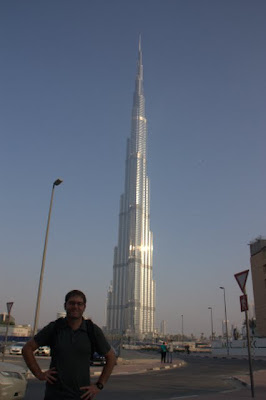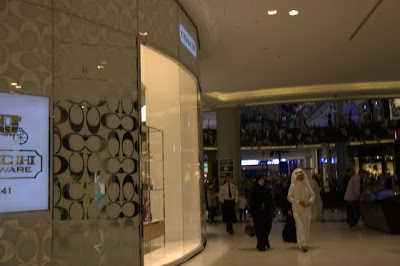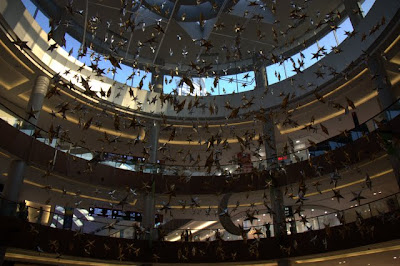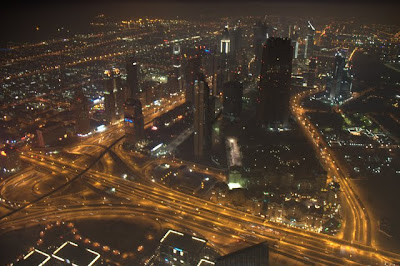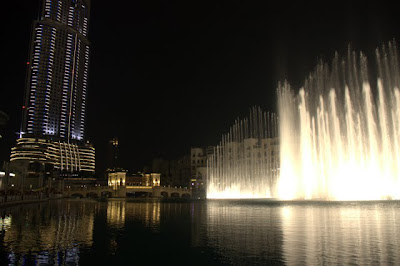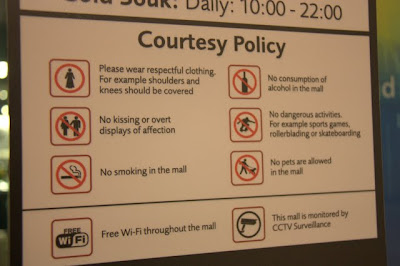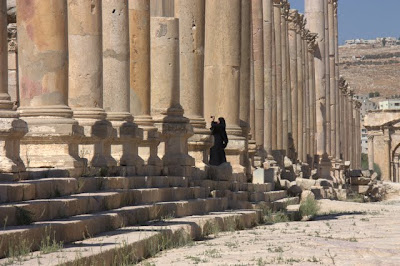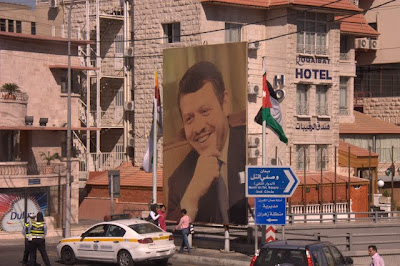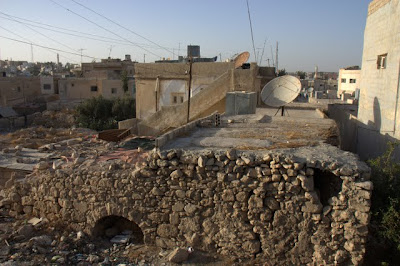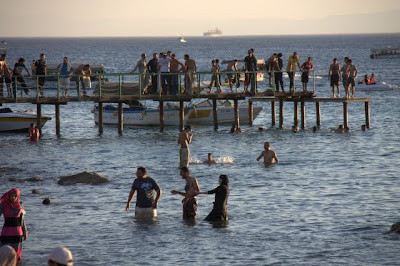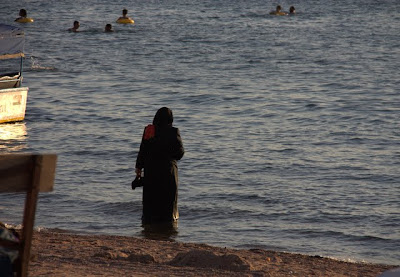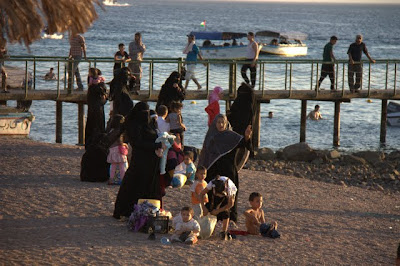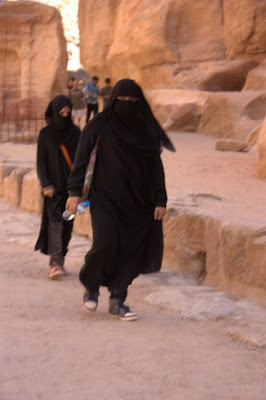The Cost to Take a Trip Around the World
I don’t know about you, but I’m incapable of reading about round the world trips without thinking in the back of my head, well that’s great, but how much did it cost?
The truth is, it depends. The title of this post is somewhat misleading. I can’t tell you how much it will cost you to travel around the world. I can only tell you how much it cost us to travel around the world. Everyone’s travel style and tolerance varies widely. Even in the realm of budget travel, there is a lot of variance. So much depends on things like the season, the country, the current economic state, and the strength of your local currency against the foreign currency, let alone personal factors like can you handle sharing a bathroom? Sleeping in a room with strangers? Taking cold water showers? Not having wi-fi? Going without a/c in the tropics? Taking public transport? Long haul bus rides? Eating on the street? Do you want to hop from country to country or city to city or do you like to stay in one place for a long time? Do you eat ramen to stay on budget or do you splurge on nice meals?
Besides travel style and other variables, the other thing to keep in mind when comparing long-term travel budgets is to determine what the numbers include. Some people include pre-trip costs like vaccinations and gear. Some people don’t. Some people include transport in their daily averages. Other people don’t, or only include certain types. Some people couch-surfed or stayed with friends, whereas others had to pay for all of their accommodations. What about things like prescriptions? Gear you pick up on the road? Travel insurance? Health insurance? Renter’s, home owner’s, or car insurance at home? Storage costs of keeping all your crap? Big ticket items like scuba certifications? Souvenirs for yourself? Holiday or birthday gifts for your family? Bills you have at home? Money you lost selling your home or your car at a reduced rate? There’s many direct and indirect costs that factor into how much a trip of this scale costs. When you’re checking out other people’s budgets, make sure you’re comparing apples to apples.
Even though I can’t tell you how much it costs to travel around the world, I’m sharing our numbers with you in the hopes that it may be a helpful starting point to someone who is trying to put together a budget. So without further ado, here’s our…
GRAND TOTAL
For the two of us to travel to 26 countries over thirteen and half months (409 days, to be precise), it cost us $71,897.46.
In this number, I’ve included the items that are most helpful for someone planning a budget:
– day to day costs (such as accommodation, meals, snacks, drinks, alcohol, activity fees, intercountry transport, tips, etc.);
– miscellaneous costs (laundry, ATM fees, exchange fees, gear and supplies picked up on the road, internet, etc.); and
– intracountry (i.e. cross-border) transport ($11,432.11).
I did not include the following items in the grand total. Many of these costs will vary widely based on your own situation. Plus, we didn’t track our pre-trip costs closely. When you are doing budget research, don’t forget to keep these costs in mind even if you don’t include them in your daily average estimate. Remember other people’s budgets may include some, none, or all of these things.
What’s not included:
– Student loan payments paid while we were away
– Minimal car insurance we kept on our car sitting at home
– Renter’s insurance for our items at home in storage (incidentally, I highly recommend looking into a renter’s insurance policy. It was cheap and turned out to cover items we brought abroad – like our stolen SLR. Our renter’s policy covered most of the loss when our World Nomads travel policy did not).
– Extra money saved as a buffer
– Cost of obtaining wills/power of attorney
– Costs of selling house/temporary housing
– Costs of selling house/stuff/car
– Costs of obtaining passports/passport photos/international drivers’ licenses
– Accountant fees for filing our tax returns while we were away
– Vaccinations, doctor co-pays for physician visits before we left, and prescriptions (guesstimate of about $2,500)
– Supplies & gear purchased before the trip (guesstimate of about $4,000 for everything except our SLR camera and camera gear)
– Storage for items we kept at home (about $1400 for the months we were away)
– High deductible health insurance we purchased to cover us in the United States (about $1,673 for the months we were away)
– World Nomads travel insurance ($1,113 for 12 months; we didn’t extend for the last 6 weeks)
– Scuba certifications ($1,201 for both of us to get our PADI certification in Koh Tao, Thailand and our advanced PADI certification in Perhentian Kecil, Malyasia)
– Gifts & souvenirs (about $2,100; includes our souvenirs, Christmas, birthday/Father’s Day/Mother’s Day/general gifts for family and friends, and shipping)
We’re pretty happy with our grand total. We never intended our budget to be firm and unyielding. Instead, we viewed it as more of a guide. We’re not the best budgeters, but it’s funny how lack of an income and a desire to keep traveling will keep you on track. We originally estimated $60,000. Had we not made the decision to add on 6 more weeks in New Zealand and Hawaii, our costs for our original plan of one year would have been about $62,710.
BUDGET IN CONTEXT
To put those numbers in context, we traveled with our budget in mind and watched expenditures, but we generally went for the best value instead of the absolute cheapest. This means, for example, that we might shell out an extra five dollars in Asia for a hotel room that was cleaner and brighter, or perhaps we would take a more expensive train instead of a bus if it got us there a lot faster. We always did our homework to be smart about our spending. We kept a close eye on ways to cut costs, like doing our own laundry when coin-op machines were available, or booking a service directly if it was just as easy to figure it out ourselves, or paying with a international fee-free credit card any place that would take it. We always had a private room and usually had private bathrooms, but from time to time we’d get a room with a shared bathroom if we were in a money saving mood. We sought out rooms with wi-fi and occasionally splurged on a/c. Because we love food and found food to be the way to the heart of a country, we ate almost all of our meals at a restaurant or on the street. We ate what the locals ate most of the time, but threw in some pricier Western style meals when we got sick of the local cuisine. We moved around a fair amount, and followed the weather even if it meant jumping around. We generally only flew when we had to, although we did take a few intercountry flights in India and one in Vietnam. We rented cars in a number of countries, but only compact or older cars. We didn’t shy away from doing activities even if they were costly, taking a when in Rome approach. (See, e.g. food and beer fest in Belgium; staying in a riad in Morocco and a ryokan in Japan; white-water rafting in Slovenia; cruising with Easy Riders in Vietnam; scuba diving in Thailand, Malaysia and Hawaii; taking a cooking class and visiting an elephant conservation center in Thailand; a candlelight tour of Petra; going up to the viewdeck on the world’s largest building in the UAE; getting up close and personal with whales in South Africa; going jetboating in New Zealand; etc.)
COUNTRY AVERAGES
There’s no doubt that WHERE you travel constitutes the biggest difference in your overall trip cost. Traveling through countries that are not as developed will drastically reduce your costs. We averaged $97.54 a day in countries that were generally less developed than at home – think of the type of places where cash is king. Our average was almost double in countries that were more developed, or about $190.69 a day. On the other hand, don’t assume that just because a country is less developed that it automatically is inexpensive. We found countries like Morocco and Jordan to be much pricier than countries like Laos and India (but much cheaper than countries like Spain and South Korea).
(Note: In order to give you an idea of what it costs to travel through different types of countries, these daily averages only include day to day costs (such as accommodation, meals, snacks, drinks, alcohol, activity fees, intercountry transport, tips, etc.) and miscellaneous costs (laundry, ATM fees, exchange fees, gear and supplies picked up on the road, internet, etc.). They do NOT include intracountry (i.e. cross-border) transport).
No big shocker here, but it was our experience that your dollar stretches the furthest in Southeast Asia, which is why we spent four months in that region. You really can get really nice rooms for $12-$25 (as long as you are willing to put up with your fair share of not so great rooms in the same price range, as quality can be somewhat inconsistent). And if you are willing to eat on the street (and hopefully you are, because the food is delicious and that’s how Southeast Asians eat), you really can get dinner for two for a couple of dollars. Our daily average in Southeast Asia was $81.70 a day, and it would have been possible to go much lower. Our daily average in Asia overall was $109.09 – flanked by a very expensive Japan on one end and a very cheap Laos on the other.
By sticking mostly to Central Europe, our European daily average was $175.92. (Note: our earlier post about European costs did not include intercountry transport, which is why those figures were lower).
Fiji – $53.48
- Total costs: $53.48
- # of days: 1
- Notes: We were only there for a long layover.
Laos – $59.82
- Total costs: $1,435.68
- # of days: 24
- Notes: The cheapest country for us!
Germany – $72.71
- Total costs: $218.12
- # of days: 3
- Notes: No lodging costs because we stayed with a friend.
South Korea – $74.10
- Total costs: $740.98
- # of days: 10
- Notes: No lodging costs for 7 days while we stayed with a friend.
Thailand – $80.44
- Total costs: $4,021.83
- # of days: 50
- Notes: Love Thailand! Includes travel through the islands during high season. We also did a lot of shopping/replenishing in Thailand so that is reflected in the cost.
Malaysia – $82.92
- Total costs: $1,243.84
- # of days: 15
- Notes: Similar in cost to Thailand, but we found lodging value to be better in Thailand. Transport in Malaysia tended to be nicer, though.
Cambodia – $91.53
- Total costs: $1,006.84
- # of days: 11
- Notes: Cambodia is pretty inexpensive, but two costs drove up the price somewhat: eating at restaurants where funds go to NGOs and fees for Angkor Wat.
Vietnam – $100.16
- Total costs: $2,504.03
- # of days: 25
- Notes: These costs drove up the price: one internal flight and guided tours (including a three day, two night Easy Rider tour, hiring a driver after Sean got sick to see the Vihn Moc Tunnels, and a mid-range overnight Halong Bay tour. Otherwise, Vietnam is a good value; you do get more for your money in lodging and food than the rest of SE Asia.
India – $107.09
- Total costs: $3,426.74
- # of days: 32
- Notes: India’s food and lodging are inexpensive. In fact, we found increasing your budget does not always bring a corresponding increase in quality. Costs are higher because we flew internally several times, including to the Andaman Islands.
Hungary – $108.78
- Total costs: $870.24
- # of days: 8
- Notes: Hungary is a good value in Europe!
Poland – $120.63
- Total costs: $482.50
- # of days: 4
- Notes: We only there for a short time, stayed solely in Krakow and ate pierogies most of the time.
UAE – $121.64
- Total costs: $243.28
- # of days: 2
- Notes: We were there twice. The first time, only to sleep in a hotel. The second time, we had a really long layover and went to the Burj Kalifa.
NYC – $129.74
- Total costs: $259.47
- # of days: 2
- Notes: This is for 2 days, one night. Our tiny hotel room alone was more than the daily average.
France – $130.54
- Total costs: $1,958.05
- # of days: 15
- Notes: No lodging costs except for one night in a B&B in Mont St. Michel and an air mattress because we stayed with a friend in Paris.
Czech Republic – $149.21
- Total costs: $1,193.71
- # of days: 8
- Notes: We were mainly in Prague, except for a day trip to Plzen. Costs tend to be higher in Prague, but you get a lot for your money. Beer is really cheaper than water here!
Jordan – $149.87
- Total costs: $1,348.84
- # of days: 9
- Notes: The activities in Jordan drive up the cost, especially the entrance fees to Petra.
Croatia – $161.39
- Total costs: $2,582.17
- # of days: 16
- Notes: This includes island hopping by ferry and a car we rented to go to Sean’s family’s hometown and Plitvice National Park. Food tended to be expensive (and average).
Slovenia – $175.83
- Total costs: $1,406.67
- # of days: 8
- Notes: This includes a car we rented for part of the time.
Morocco – $180.68
- Total costs: $2,710.17
- # of days: 15
- Notes: This includes a rental car and shady fees charged by the rental company.
Portugal – $186.78
- Total costs: $1,307.47
- # of days: 7
- Notes: This includes a rental car.
Northern Ireland – $195.51
- Total costs: $1,173.03
- # of days: 6
- Notes: This includes a rental car.
Spain – $202.83
- Total costs: $4,665.01
- # of days: 23
- Notes: This includes a rental car for a few days.
New Zealand – $205.03
- Total costs: $6,150.98
- # of days: 30
- Notes: Includes campervan rental in shoulder season. We did cook a lot, but when it rained for days on end, we ate out more than we planned to get us out of our campervan.
South Africa – $222.89
- Total costs: $6,017.93
- # of days: 27
- Notes: This includes a rental car.
Japan – $237.02
- Total costs: $7,110.45
- # of days: 30
- Notes: This includes a Japan Rail Pass.
Hawaii – $237.36
- Total costs: $2,136.22
- # of days: 9
- Notes: This includes a rental car.
Ireland – $261.03
- Total costs: $3,654.45
- # of days: 14
- Notes: This figure is estimated; we lost track of our budget quickly after many a round of Guinness. Costs are also higher because we rented a car and went out more than usual while our friends were visiting.
Belgium -$271.59
- Total costs: $543.17
- # of days: 2
- Notes: This just for a 2 day, one night trip to Brussels. Again, costs were probably higher because we drank a lot with our friend (alcohol will get you every time!) and bought an excessive amount of chocolate.
SETTING THE BUDGET AND MAKING IT HAPPEN
Traveling around the world sounds like a pipe dream, but all it takes is prioritizing travel above other things in your life, whether it be your car, your house, your wardrobe, your gadgets, etc. Getting Sean’s sweat equity out of our fixer-upper before we left was instrumental increasing our money stockpile, but so was living well below our means and several years of saving. If you want to do it – really want to do it in reality, not just in theory – you can make it happen. And you should make it happen. Because I can tell you, as much as it stung to find out in the middle of India that the sellers to whom we sold our house – you know, the one that we poured our hearts and souls into for four years – sold the house for $30,000 more less than a year after we sold it to them, the sting dissipates quickly when you realize, holy crap, I’m in India.
If you want to travel but don’t have the ability, desire, or time to save $60,000 or $70,000, don’t be scared by our numbers. It is absolutely possible to travel around the world for a long period of time for less than we spent. Check out two good round-ups of other traveler’s budgets here and here. If you want to or need to spend less, there are many ways to reduce the grand total. (And many ways to increase it, should you want to travel more extravagantly). For example, to cut costs, go for 11 months instead of a year. Go to fewer places for longer periods of time. Stick to countries that are less developed. Go in the off season. Skip pricey activities and stick to soaking up the atmosphere. Select accommodations where you can cook yourself. Consider couch-surfing. Don’t rent a car and take public transport. Limit the amount of fancy gear you buy in advance. There’s lots of ways to save, so don’t let money stop you from traveling. Prioritize what it important to you when traveling – location, accommodations, activities, comfort, value, lowest cost, weather – and the rest will fall into place.
We were fortunate to have enough money in the bank that we didn’t have to be slaves to our budget and could travel, for the most part, without money hindering our choices. We could have spent less, sure, but at this stage in our lives, we wanted a certain level of comfort and decided if we were going to do it, we might as well do it. And we could have spent more; there were times when we felt like spending a little more money would have allowed us to do more things or be more comfortable. But overall, we were happy with our style of travel and what it cost to travel that way. Because there are so many variables, setting your budget will not be an exact science. Once you have an idea of how much it cost other people to travel the world, you may want to pick a number that is feasible for you to save and that you feel comfortable with spending, and work from there to make your travels fit your number.
Let’s Go to the Mall!
We ended up with layovers in the United Arab Emirates on our way to and from Jordan. Considering we only spent about 24 hours total in the country, and the first visit was pretty much spent sleeping, the UAE would hardly warrant its own post. Except our second visit – the one we spent awake during a long 12 hour layover – gave us a brief introduction to the over-the-top excess that the UAE is famous for.
We inquired at the tourist office to see what they suggested we see during our 12 hour layover. The woman behind the desk said, why, go to the Dubai Mall, of course. It is what everyone does!
She was right. The mall was packed. And quite a sight. Picture every upscale and luxury brand in the United States and Europe, and put them in the same mall with air conditioning blasting to make you forget you are in the steaming desert. Add a bunch of men and women in traditional Muslim garb shopping for said luxury brands. Throw in all of the restaurant chains you can think of. Don’t forget a giant aquarium, the grandest music-and-light show possible, and an ice rink in the center of it all. And, naturally, the world’s current tallest building built specifically with extra tallness thrown on top just because they could.
Fun, no doubt, but the most conspicuous display of spending money just to spend money I’ve ever seen.
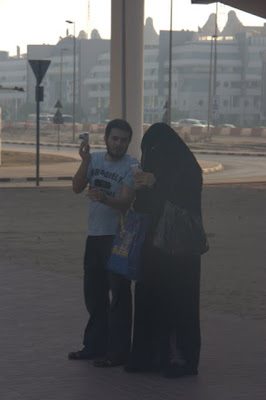
There were even more women wearing the full hijab in the UAE than in Jordan. Sometimes the men they were with were in Muslim garb, but very frequently, their companions were in casual clothes - jeans, t-shirts, even a sleeveless shirt and shorts.

Why do I despise chains at home but are drawn to them like a magnet on the road? Just like the Chili's at home, but add a giant aquarium and subtract alcohol.

Hard to get a good picture of the ice rink with the glare, but you get the gist. Note the pools of melting ice, which made sense considering it was at least 100 degrees outside.
More Jordan, in Pictures
To wrap-up Jordan, here are some pictures of places that didn’t really make it into other posts.
Jordan Beyond the Sites
Going to Jordan was Sean’s pick; to be honest, I felt very little enthusiasm towards travelling there. I mostly wanted to get it over with to get on to the Asia part of our trip. But as things usually turn out on this trip, even if I couldn’t say it was always fun to travel there, it certainly was fascinating.
I knew very little about Jordan before we travelled there. I knew it is in the Middle East; it is mainly Muslim; and they have a very pretty Queen (who I once saw on 60 Minutes).
Looking at Jordan on a map, it doesn’t seem like it is very safe place to travel. It shares borders with Israel, Palestine, Syria, Saudi Arabia, and Iraq. Despite its position in an area of turmoil, Jordan has managed to maintain good relations with both its Middle Eastern neighbors and the Western world. Jordan’s permissive policies towards accepting Palestinian and Iraqi refugees have left it struggling to figure out how to bear the burden of the additional people it let inside its borders. There are actually more Palestinians living in Jordan than native Jordanians.
Although Islam is the country’s official religion, Jordan is tolerant of other religions and generally keeps religion and government at arm’s length. Jordan has one of the largest Christian populations in the Middle East. Most of the Christians live in Madaba, a small city just south of Amman that we visited for a few days. We arrived in Jordan during the tail end of Ramadan, a Muslim holiday that involves fasting between sunup and sundown for a month. It is one of those holidays that never have a set date, so we asked the owner of the hotel we were staying at in Madaba when Ramadan was ending. Um, I don’t know, I’m not sure when it finishes. Hmm, I thought to myself, is he a heathen or something? How does he not know when it ends? After rifling through the calendar, he responded, Yeah, I think they finish celebrating on Thursday. After a pause, he continued, I’m Christian, so I get to eat, drink and smoke whatever I want! I felt ashamed for automatically assuming he was Muslim just because he spoke Arabic and was from a Middle Eastern country. The first of many lessons I learned during our 10 days in Jordan.
Like many developing countries, Jordan has the usual frustrations and curiosities: busses that do not leave until they are completely full; cities that look like they are either perpetually unfinished or falling apart due to empty lots filled with crumbling rubble, giant holes in any paved surface, and steel rebar sticking up from buildings; an ever-present layer of dust and litter; constant exhaust fumes filling the air; and accommodations that make you cringe if you look too closely. Noticeably absent were aggressive people looking to make a buck at your expense. Unlike Morocco, no one hassled us, no one followed us, no one tried to scam us.
Noticeably present, however, were the differences in the way that men and women are treated. Jordan does have a more liberal attitude towards women, but more liberal is relative, of course, to the Muslim countries that don’t give women any rights. I was never uncomfortable travelling through Jordan, but certain things stood out to me. I refrained from wearing my shorts, dress or tank-top for the most part, and do not consider my v-neck shirts to be particularly low-cut, but I could feel eyes gravitating toward what little skin I showed and often chose to wear a scarf around my neck just to avoid any extra attention. Time and time again, we were warmly greeted by Jordanians, with a welcome, welcome. But sometimes, it seemed I was more welcome than Sean, because the phrase and their eyes would be directed at me as if Sean wasn’t there.
Early on in our trip, a well-travelled Jordanian man told us that he was embarrassed by the way that Jordanian men acted because they didn’t know how to act around women. Other than the porn display in the desert, we saw this most clearly when we went snorkeling in the Red Sea. Taking a break from snorkeling, we watched all of eyes of the Jordanian guys sitting under the shelter near us follow a French girl wearing a bikini walk to the shelter from the water. While the rest of them stared, one of them struck up a conversation with her. You have great skin, one of them said, never removing his eyes from her. Um, thanks, she mumbled. Need help with your suntan lotion? The whole scene was awkward, to say the least.
I was curious what exactly people wore to the beach in a country where most of the women still wore at least a head covering. I wouldn’t get my answer at this beach, which was located outside the city close to a cluster of dive centers. At the public beaches close to downtown Aqaba, however, women went in the sea with the same attire they wore on land, while the men wore swim trunks or perhaps a sleeveless t-shirt as well.
Perhaps this is why it struck me as odd, later, when a woman who was essentially covered from head-to-toe pulled out her breast to breast-feed her child on a public bus. Her child was wailing at the top of his lungs, and everyone on the bus – mostly men – glared in disapproval. I took a chance and turned around in my seat to play peek-a-boo with the child. His cries turned to laughter. The woman smiled at me, and I smiled back. A few minutes later, when I turned around again, I noticed her breastfeeding. Perhaps Jordan views this activity as something that is necessary for a child’s well-being – I see that they have breast-feeding laws protecting working mothers – but this didn’t seem to mesh with the sight of woman after woman completely covered up, some head to toe.
I know the women’s dress in Muslim countries is a complicated subject, and I don’t even present to understand the intricacies behind wardrobe decisions. It was continually jarring for me to see how much most women covered up even in a supposedly liberal country like Jordan.
For its small size, Jordan has lots of interesting and beautiful sites. But even beyond the sites, it is a fascinating country with a distinctly Middle-Eastern culture. In the end, I was glad we made a foray into the Middle East and got to know Jordan more than we did at the beginning.
Low Point on Our Trip
Well, in Jordan, we finally reached the low point on our trip. Actually, we reached the lowest point on earth that we’ll ever go: the Dead Sea. The Dead Sea touches Jordan and Israel not too far away from Amman and Madaba. Not only is the lowest point on earth, it also has four times the salt content of any ocean, making it impossible not to immediately float once you hit the water.
We hired what was supposed to be a budget driver from our budget hotel to take us to the Dead Sea and back to Madaba, but by the time you add in the cost of the driver and the 15 JOD admission fee to the tourist beach they take you to, it was quite a costly morning. There are supposedly public areas you can visit, but our driver acted like he had never heard of that.
We didn’t stay in the water long, because it was a challenge to avoid getting the super salty water in your mouth, and it stung my sensitive skin. But it was fun being buoyant for a while. And people – especially those trying to sell you the Dead Sea products – believe the minerals in the water have health benefits, so why not go for a swim?
Naturally, it is obligatory for every traveler who goes to Jordan to make the trip to the Dead Sea and take a photo bobbing around in the water. I think it must be a condition of getting your Jordanian visa, or something, so who were we to argue?

